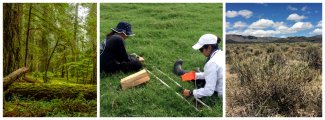Spotlight
EREN-NEON Flexible Learning Projects Enable Socially Distanced Ecology
February 17, 2021
The pandemic has created new challenges for educators—but that doesn't mean learning has to stop. The Ecological Research as Education Network (EREN) collaborated with the NEON program in 2020 to create a series of Flexible Learning Projects that enable students to practice hands-on field ecology wherever they are—on campus or at home.
Bringing Ecology to Your Local Campus—Or Backyard
The EREN-NEON Flexible Learning Projects, funded through a National Science Foundation (NSF) grant, were designed specifically for hybrid or online learning. The modules support hands-on, socially distanced field ecology with projects that can be completed with data collected in local parks, nature preserves, on campuses, or in a student's backyard. The projects are equally suitable for both urban and rural environments.
Dr. Laurel Anderson (who goes by Laurie) is the President of the Board of Directors for EREN and is the Principal Investigator for the project. She explains, "We have been collaborators with NEON for a long time. As the pandemic started closing campuses in the spring of 2020, we had a conversation with Dr. Paula Mabee [the NEON Observatory Director] about ways that NEON and EREN could support students and teachers during this time. We realized that the distributed, multi-site networks that EREN and NEON represent would be ideal for educational projects where students could collect data at their own sites while social distancing."
The project team created four Flexible Learning Projects, which were rolled out to postsecondary educators through a series of webinars in Summer 2020. Educators were also able to participate in continued mentoring and support through the Faculty Mentoring Network with QUBES. The initial projects included:
- Backyard Pollinator Surveys
- Plants in the Human-Altered Environment
- Mosquito Surveys along Anthropogenic Impact Gradients
- Lichens in Diverse Landscapes
In January 2021, they added two new projects:
- Sapsucker Tree Use Across Diverse Landscapes
- Using Space and Time to Explore Phenology
Notes from the Field: Flexible Learning Projects in Action
Faculty members from more than 30 institutions participated in the projects in Fall 2020, and more than 770 students took part in the Flexible Learning Project activities. Students uploaded their data into a shared space so it could be compared across all of the participants. Students also compared their data to data collected at the NEON field sites. The NEON data provided an opportunity to see how their local observations compared to those collected in different biomes across the continent and to look for larger patterns across spatial and temporal scales.
Dr. Emily Rollinson is an Assistant Professor of Biology at East Stroudsburg University (ESU) in Northeastern Pennsylvania. She used the Plants in the Human-Altered Environment module as a core part of the laboratory sequence for her Plant Ecology course. She says, "My laboratory courses, along with many of the ecological and organismal courses in our program, have a strong field research component. Many of our labs rely on field trips to local natural areas, including opportunities for data collection and original research in those locations. In Fall 2020, this posed a real challenge, as we transitioned all of our courses to a remote format, without the in-person laboratory classes and the associated field trips."

Terrestrial plant data being collected by NEON field scientists. Photos from left to right: Wind River Experimental Forest field site; Field ecologists conducting herbaceous clip harvest sampling at the Lajas Experimental Station field site; Onaqui field site.
Twenty undergraduates and three graduate students participated in the project for Rollinson's class. She modified the field methods to enable students working remotely to complete data collection with minimal equipment and carry out measurements independently. She says, "Because the project was explicitly designed to compare plants across human-altered and more natural environments, students were able to participate from home, no matter where they were located. Some chose to work in local parks or other natural areas, while others were able to use their own yards, and all of those field sites were equally valuable to the project."
Students compared the data they collected with data from the NEON program, including plant community composition and woody plant vegetation structure. Rollinson explains, "Adding the NEON data allowed students to also look at patterns of diversity across broader spatial scales. Most of our students are local to ESU, so the plots surveyed by the class were largely clustered within our region. That meant that, within the class data, students didn't see any effect of factors like climate variation on the diversity of trees in their plots. By adding the NEON sites, students were able to recognize that spatial scale has an incredible effect on the ecological patterns we see. The factors that predict variation in species diversity at a local scale are different than the factors we'd see across biomes."

At Greensboro College in North Carolina, students in Dr. Sandra Cooke's Ecology course used the Lichens in Diverse Landscapes and Backyard Beetles and Pollinators modules. Cooke says, "I like how these projects enable me to integrate authentic research into my undergraduate courses. I feel like I am providing my students with meaningful lab activities because they are collecting real data that will be used by scientists, rather than just doing a 'cookbook'-style lab that has been done many times over and often leads to predictable outcomes."
For the lichens project, Cooke's students explored the relationship between lichen presence and air quality parameters to determine if lichens could serve as an air quality bioindicator. Using both locally-collected data and NEON data, they created simple scatterplots of Lichen Index vs. nitrate deposition, Lichen Index vs. sulfate deposition, and Lichen Index vs. pH to visualize how these air quality metrics may correlate with Lichen Index. Cooke also developed one of the new NEON-centered projects focused on sapsuckers and their use of trees across diverse landscapes.
Connecting Local and Continental Data

Moving forward, EREN will continue to make the Flexible Learning Projects freely available for educators to use through 2021 and beyond. They are also continuing to add new learning modules. All six modules can be found at http://erenweb.org/eren-neon-flexible-learning-projects/. Archived recordings of the introductory webinars can also be accessed here.
Anderson says that the value of the Flexible Learning Projects will go far beyond the pandemic. "I'm really excited that we had the opportunity to collaborate with NEON," she says. "The pandemic provided some opportunities for educational innovation that we want to keep and learn from. It also helped us to see where there are inequities in terms of where students have opportunities to access and work with large data sets. These projects will continue to be incredibly valuable, with or without the pandemic."
She is especially excited by the way the EREN-NEON Flexible Learning Projects connect continental-scale data with the hyper-local. She says, "NEON data provides context for local data collection. Students can connect what they are seeing locally with data collected at a larger scale, which allows them to see trends and possible mechanisms." She sees hyper-local data collection as the key to keeping students, and the public at large, interested in ecological questions. "One of the things that is really important in ecology going forward is that we center our science in community-relevant problems and the things people care about in their own local environments. These projects are meant to direct student attention to issues around biodiversity and ecological phenomena in their own communities, whether they are in urban or rural environments, working together on campus or alone in their own backyards. Keeping that focus on the local makes ecological questions personally relevant."

